Oxford's traditions: Merton's time ceremony, beating the bounds and more
- Published
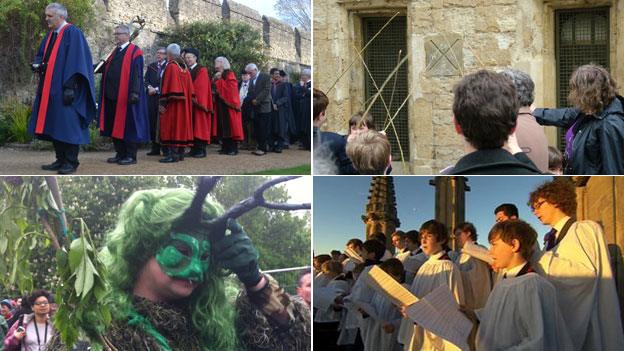
From ancient ceremonies that were once practical necessities to the truly bonkers, Oxford is a place where an array of historical traditions are kept alive.
In the week that Merton College students perform their "Time Ceremony" and the Lord Mayor and city councillors inspect the city's walls, BBC News takes a look at these and the city's other weird and wonderful traditions.

Merton College's Time Ceremony
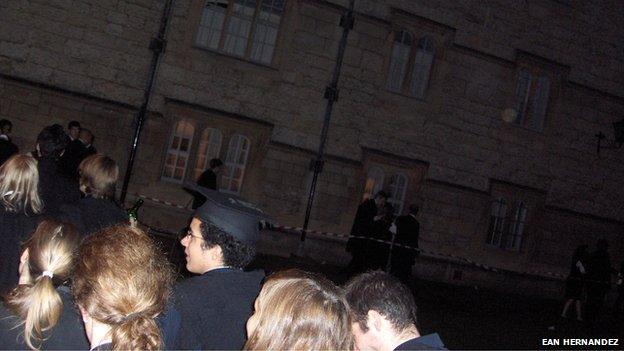
The group starts at 2am at the sundial on the lawn in the quad and walk backwards for an hour
It is a tradition shrouded in mystery and only Merton College students are permitted to attend.
But their time ceremony - in which Mertonians walk backwards around the college's Fellows quad in full academic dress in the early hours of the last Sunday in October - is believed to have saved us all.
The students claim the annual event rescues the universe by "stabilising the time-space continuum" - while also giving them the excuse to gather and drink port.
The strange ceremony began at 02:00 BST at the sundial on the lawn in the quad and participants walked backwards for an hour, taking breaks to quench their thirst. By the time they had finished it was 02:00 GMT.
Oxford-based Richard O Smith, author of "Oxford Student Pranks, a history of mischief and mayhem", remembers attending a ceremony.
"This supposedly ensures a safe transference to Greenwich Mean Time by what Jeremy Paxman described, when introducing an episode of University Challenge featuring Merton College, as 'counteracting the temporal vortex'," he said.
"This is accomplished by walking backwards around a quadrangle in full academic dress for an hour at 2am until 2am - as the clocks go back one hour, so you finish when you start - whilst liberally swigging port.
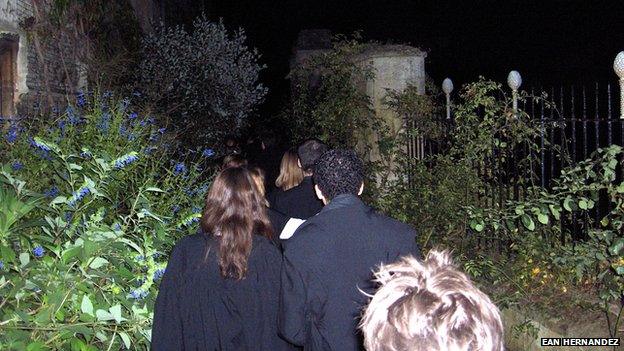
Students walk backwards in full academic dress
"A Mertonian, when asked "Why do you walk backwards?" replied: "Because walking forwards at two o'clock in the morning in full academic dress would just look silly." Obvious, really."
The tradition began in 1971, when only five people turned up. But its numbers have increased since then.
"Initially this quirky event was secret, discovery risking the wrath of college authorities, but later became embraced by the JCR and college itself," Mr Smith added.
"However, glasses have now been banned, but crucially, not port. Though since students nowadays link arms during the backwards walk, holding a glass would be difficult."

Oxford's city wall inspection
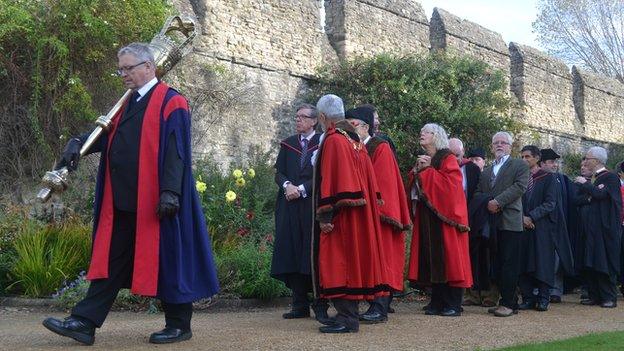
Oxford's Lord Mayor and the city councillors parade through the grounds of New College
Back in the 12th Century the inspection of Oxford's city wall was to ensure the city was safe from invaders.
Now, it's a colourful spectacle that has been kept alive by New College since the Middle Ages.
The ceremony, which happens every three years, begins with a procession of the Lord Mayor and the city councillors to the college.
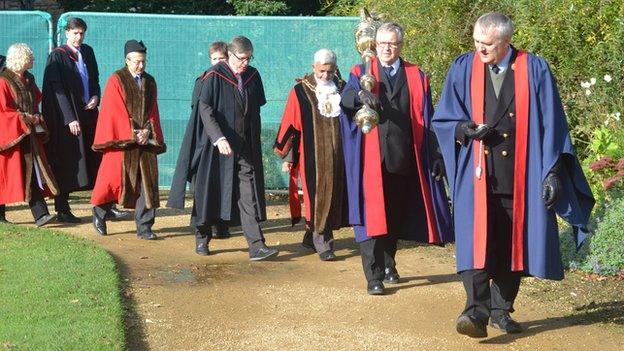
The ceremony happens every three years
"They arrive at the Queen's main gate and the sergeant of the mace knocks on the door with three raps," said Caroline Thomas, the college's home bursar and sub-warden.
"The head porter opens the door, they ask permission for the city council to come in and the head porter shuts the door in their face. He asks the warden if they may come in and inspect the wall and he says yes."
The college places scaffolding by the wall, which is more than 630 years old, so the councillors can climb to the top and inspect it.
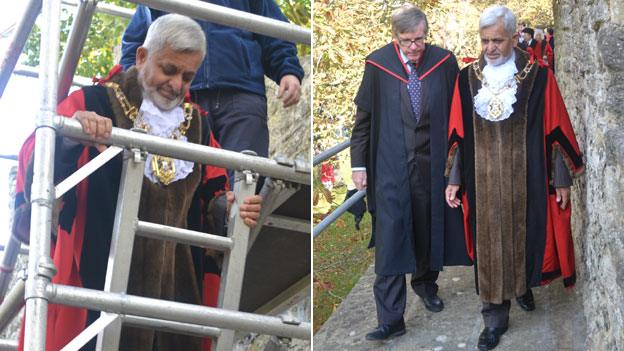
Oxford's Lord Mayor and city councillors scale the wall using scaffolding
It all began in 1379 when the Bishop of Winchester built the college on land bought from the king. It meant the city walls could not be inspected from inside the city without going into the college's grounds.
The bishop was given the land on the condition the college should keep the walls in repair. It made two entrances at each end so the mayor could view the wall every three years.
It is believed the triennial inspection was carried out up until the 20th Century, although it appears to have lapsed during World War One before being revived again in 1957.
New College's bursar David Palfreyman said the college had spent £100,000 on maintenance work for the wall in the past nine months.
He said the event was more ceremonial rather than a full inspection, but in the past the city would be looking for any damage and to check the wall was in good condition.
"The inspection is a bit of fun," he said.
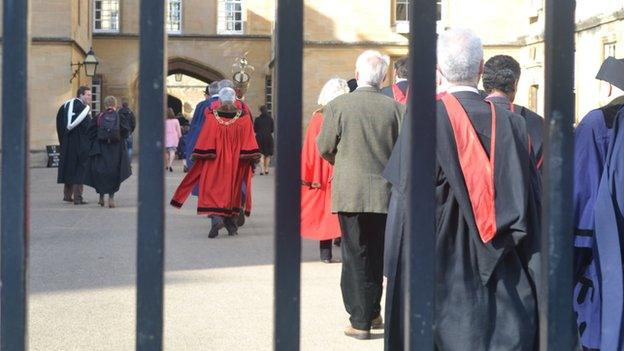

Beating the bounds
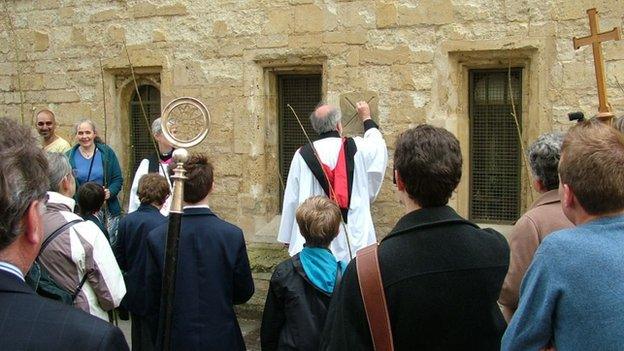
Beating of the bounds takes place in Oxford every year on Ascension Day
A crowd of people armed with sticks is something that visitors to the city are likely to see on Ascension Day every year.
However, this unusual sight is not a riot, but in fact a crowd taking part in beating the bounds, an annual tradition of marking the boundary stones by hitting them with willow sticks.
A procession of clergy and dignitaries follow the ancient route around the landmarks and chants "Mark! Mark! Mark!" while beating the stones.
"At each stone I mark it, I date it and some people strike the stone shouting 'Mark!'," said the Very Reverend Bob Wilkes, the city rector at St Michael At The North Gate church.
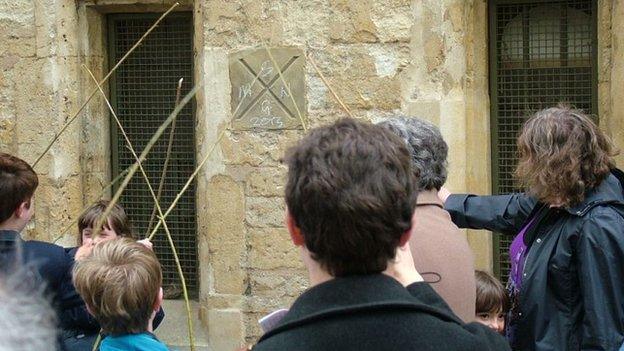
The crowd beats the boundary stones with willow sticks and chants "Mark! Mark! Mark"
There are 29 boundary stones in Oxford that mark the parishes of St Michael at the North Gate with St Martin's and All Saints.
The unusual ceremony dates back more than 600 years, when ecclesiastical parishes set different taxation rates.
"It could make a lot of difference which parish you lived in, so it was important to know who lived in your parish," Mr Wilkes said.
"We shout 'Mark!' to shout 'this is our boundary'. If you are not in our boundary, go, and if you are you will be expecting our tax bill."
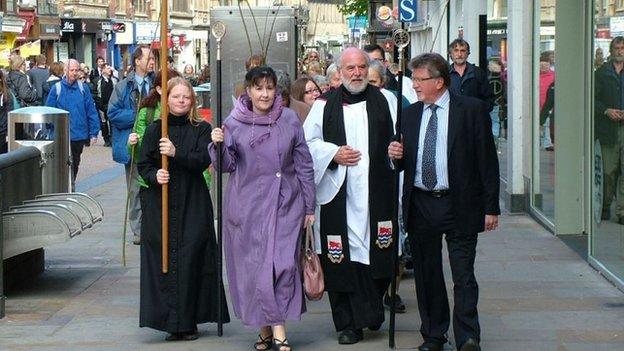
The procession visits strange locations on the route including the ladies department in Marks and Spencer
Because large areas of the city have been built over, the group visit some strange locations, including the stock room of the clothes shop Zara, while there is also a boundary stone in the floor of Marks and Spencer.
"We find as we process round in my robes and people holding sticks, we do look a bit odd. Tourists latch on," said Mr Wilkes.
"It is one of the ways as a church we relate to the businesses and life of the city."
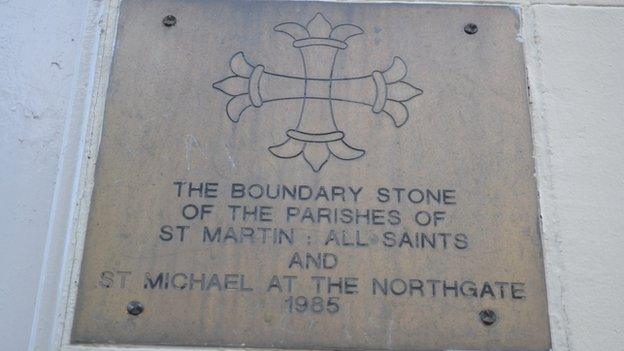
A plaque marking the boundary stone that Boots was built over in Cornmarket Street, Oxford
The beaters of St Michael at the Northgate then have lunch at Lincoln College, which opens the connecting door with Brasenose College.
Mr Smith said the college served ivy beer to make it green and "off putting", to discourage the rival Brasenose students from taking advantage of the hospitality.
There are other churches in Oxford that beat their boundary stones, including the University Church of St Mary the Virgin. These beaters enjoy cherry pie at All Souls college.
Mr Smith said the this was because All Souls was built on the site of a cherry orchard.

May Morning

There are celebrations across Oxford on May morning
As the sun rises over Oxford on 1 May every year, thousands of people gather on Magdalen Bridge to hear the college's choir sing from the top of their tower at 06:00 BST.
But the origins of the tradition are not clear.
"We know the choir singing had begun before the Great Tower was built and moved up there then," said Magdalen College's home bursar, Mark Blandford-Baker.
"The college was founded in 1458, the tower is 50 years younger. There is no precise date nor any certain background to why or how it all began, however the format today is essentially unchanged from 506 or so years ago."
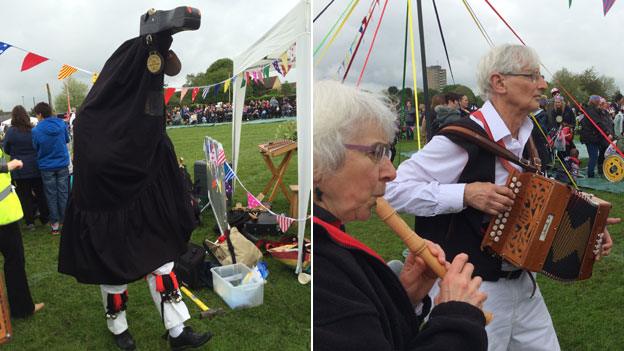
Festivities are held in other parts of the city including Blackbird Leys
"It is an event where people sometimes stay up all night or they get up really early. You can hear a pin drop while the choir sings. It is quite a beautiful moment," said Rachel Capell, the city council's events officer.
There are also festivities around the city including live music, Morris dancers and other performances.
"Some of the folk groups, they co-organise their performances between them, then if you happen to stumble on these it feels like bits of culture have erupted out of the street."
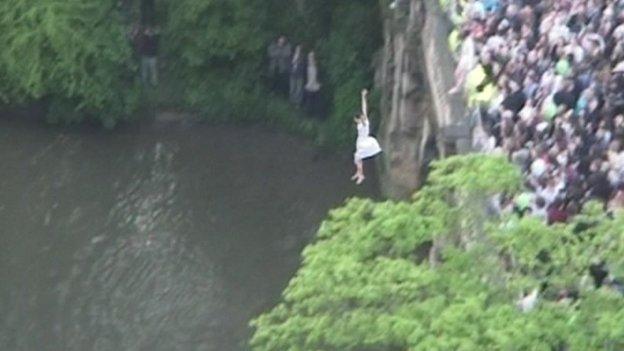
Forty people had to be seen by paramedics after jumping off Magdalen Bridge in 2005
People jumping off Magdalen Bridge into the shallow waters below were a familiar sight until 2005, when about 40 people were hurt after they ignored police and jumped into about 2ft of water.
The bridge was closed each May Day from 2006 until 2011 but increased security has allowed it to be reopened since.
"The last four years we have been co-ordinating the event at the bridge so it can grow into the cultural event it is rather than it being about people jumping from the bridge," said Ms Capell.
On a weekday the event can attract 4,500 to 6,000 people but on a weekend as many as 15,000 people join the festivities.
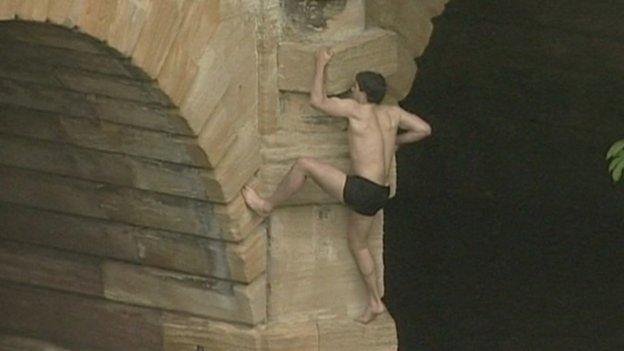
High security at the event now stops people from jumping off Magdalen Bridge
- Published1 May 2014
